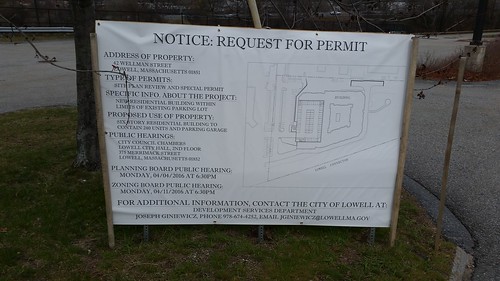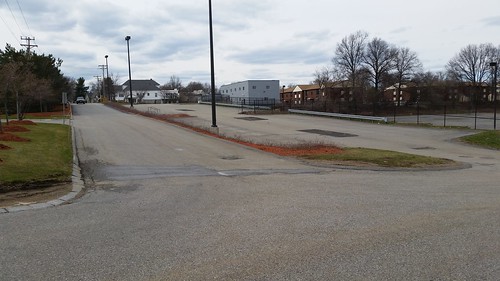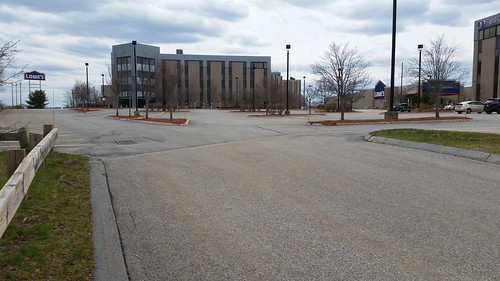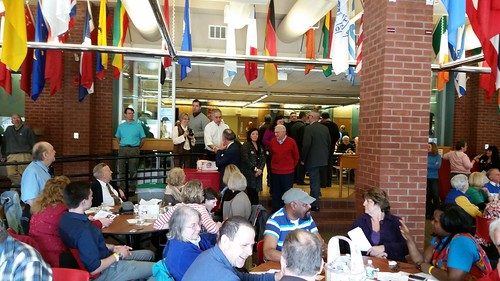Lowell Week in Review: April 10, 2016

Posted planning board notice on Wellman St
Apartments on Wellman Street
Councilors Bill Samaras and Jim Leary had similar motions on the council agenda last Tuesday (full report on Tuesday’s meeting HERE). Both wanted reports from the city manager on the benefits of residential versus commercial use at Connector Park, the location of the large parcel at the end of Wellman Street (near the Lowe’s store) whose owner proposes building 240 apartments. The site is currently zoned for commercial use, but the planning board can issue a special permit that would allow an apartment building to be constructed.
What began as a request for a report quickly morphed into some fascinating parliamentary maneuvering by Councilor Leary and Mayor Kennedy. At Kennedy’s urging, Leary made a substitute motion asking that the zoning of the parcel be changed to eliminate the special permit for residential use option. Other councilors immediately expressed concern that the developer, having relied on current zoning to make preliminary investments in the project, might seek damages if the change was made. City Solicitor Christine O’Connor explained that if the council published notice of a public hearing to change the zoning prior to the developer publishing notice of a planning board public hearing (which has not yet happened) then the developer would be bound by the change. Kennedy pointed out that the property is currently zoned industrial and that the developer had no right to “expect” to receive the special permit.
Both Leary and Kennedy seemed most motivated by the fact that this is the last parcel in the city on which a high rise office building could be constructed while there are many sites available for apartment buildings. Given the site’s proximity to Cross Point – it’s just a few hundred yards away – and the possible drawing power of Kronos when it occupies that building, it would be very short-sighted of the city to part with this parcel for the short-term gain of an apartment building.
While some of the councilors agreed with the argument in theory, they said they did not want to act impulsively. They expressed a willingness to consider a modification of the zoning, but only after receiving a report from the city manager on the best strategic use of the parcel.
There’s a bit of a race going on here, because if the developer gets its formal proposal before the planning board before the council makes the change, the developer’s rights will be grandfathered in under the existing rules, not the new ones, so no zoning change would affect this project.
In the end, Mayor Kennedy, along with Councilors Leary, John Leahy, and Bill Samaras, voted to make the zoning change as soon as possible. Councilors Jim Milinazzo, Dan Rourke, Corey Belanger, Rodney Elliott, and Rita Mercier voted against making the change (at this point, at least).
Although not formally before the Planning Board, the developer has appeared before that board twice for informational and feedback purposes. On both occasions, the Planning Board seems to have embraced the concept of the apartment building without demonstrating any consternation over using up a rare commercial site for residential use.
However, planning board members have expressed concern about the lack of regard for pedestrians. (See Judith Durant’s report from the last Planning Board meeting that addressed this project).
As the photos below show, neither Wellman Street nor Lowe’s Way have sidewalks. I don’t believe that the developer’s proposal does anything to address that. Well, it does in a way. It provides 498 parking spaces at the entrance to the building, making it abundantly clear that the expectation is that those who rent the apartments will arrive and depart in their own cars every day, driving off to work somewhere on the nearby interstate highway system.

Wellman St, looking towards Chelmsford. Apartment building would be to the right

Looking towards Cross Point on Lowe’s Way from apartment building site
I’m not sure where I come down on the industrial versus residential use. I’m more concerned with reversing some of the misguided 1960s-era urban planning decisions that have shaped that section of the city for a half century. Chelmsford Street and Industrial Ave are both speedways that through their design, signal drivers to proceed at high speeds. Even the most basic of pedestrian amenities, like crosswalks and crossing lights, are afterthoughts if they are there at all. It’s a shame, because with all the beautiful houses of the long-established Highlands neighborhood just across Chelmsford Street, you have plenty of people who could easily access this area on foot if it was safe to do so. Look at the amenities the neighborhood has – a movie theater (Lowell Cinema), several restaurants, two grocery stores (Market Basket and Stop and Shop), the Bruce Freeman Trail, and a potential walking trail along the abandoned rail bed that runs under the Lowell Connector and links the Industrial Ave rotary to Plain Street, which is just a 10 minute walk by that route. As it is now, the thought of crossing Chelmsford Street on foot in that vicinity is a risky, inconvenient undertaking, so thousands of people are deprived of the opportunity to experience that neighborhood in full unless they jump in their cars and drive.
The same design principles that I and many others have advocated for the Lord Overpass and Thorndike Street should be applied to this project and this neighborhood. The question shouldn’t be which use of the Wellman Street parcel will yield the most property taxes; the question should be which use will make this a better neighborhood in the strategic, community-building sense. If you do that, the taxes will follow.
College Town
A few council meetings ago, Councilor Samaras requested an update on what the city has done to implement the “college town” initiative. In this week’s council packet, there is a four-page response from Diane Tradd, the DPD Director.
Under the heading “Development Opportunities,” three things were mentioned that might be of interest to readers:
Pulchino-Tong Business Building – In the spring of 2014 UML held a groundbreaking for their new business school, the latest in a series of new construction projects on campus. The $40M project is expected to open in 2017.
Boston and Maine Railroad Depot – In June 2015 MCC celebrated the groundbreaking of their new performing arts space in the former B&M Railroad Depot (aka the Rialto Building) on Central Street at one of the main gateways to downtown. Construction is expected to take 18 months.
Private Dorm Opportunities – In the past few months, several private developers have expressed interest in building private student dormitories in the City. DPD staff have advised them of the local permitting process.
Among the many undertakings and events included in the report, one in particular caught my eye:
“UMass Lowell and City of Lowell Safety Walks – On April 13 and April 20, staff from the City of Lowell and UML will be joining a focus group of students to walk several main pedestrian corridors. The intent of these walks is to identify lighting, safety, and infrastructure concerns that students may encounter on streets that connect UML campuses and downtown.”
It’s all about Walkability

Tour participants who braved the wind and rain on Thursday night
Downtown First Thursdays
Speaking of walkability, this past Thursday I led the first Lowell Walk of 2016 as part of the Downtown First Thursday events. Despite high winds and heavy rain that put in mind one of the golf course scenes from Caddyshack, sixteen people, including four UMass Lowell students, joined the tour. Because everyone who showed up knew what they were getting into weather-wise, the conditions promoted more giddiness than misery. We were all rewarded when the rain stopped mid-tour and a rainbow appeared over the Appleton Mills. It was a good omen. It was also a reminder that you can find fun and interesting things to do anywhere in Lowell IF YOU GET OUT OF YOUR CAR AND WALK AROUND.
The next Lowell Walks tour will be Saturday, April 23 at 10 am. It will be led by Professor Bob Forrant and it will begin at the Hawk’s Nest which is the snack bar inside the University Suites Apartments on Aiken Street, right across from Lelacheur Park. The topic of Bob’s tour will be Urban Renewal. The tour will cover the Northern Canal urban renewal project of the 1960s which demolished the Little Canada neighborhood and the mills and associated buildings of the Merrimack Manufacturing Company. It was a massive undertaking that never yielded the intended results. Bob will also be involved in an upcoming symposium, “Reclaiming Urban Renewal: Community Efforts and Impacts in Lawrence, Mass and Other Industrial Cities” on May 7, 2016 at the Lawrence History Center. I know Lowell’s experience will be prominently featured at the symposium, so please consider registering and attending.
For more information about Lowell Walks, check out the “Upcoming Events” in the left column of this site or see the full Events Page and then sign up for the Lowell Walks newsletter by entering your email address in the box at the top of the right column of this website.
“Random” Shooting
Preparing for Thursday’s tour, I jokingly mentioned to someone that leading a group through the wind and the rain might be characterized as “adventure touring.” That label took on a whole new meaning when I learned that someone had been shot in a hallway at 9 Central Street, only fifteen minutes after our tour passed just a block away.
I haven’t learned much more about this incident but I have heard it described as a “random” shooting. To me, “random” means you are walking down the street, minding your own business, when you are suddenly struck by a bullet. Those are the kind of scenarios that make people crazy. Fortunately, they are extremely rare. Most shootings seem to involve individuals who know each other and who are already breaking or skirting the law. The same report that characterized this shooting as “random” also said that witnesses were not cooperating with the police. That’s usually an indicator that victims, assailants, and witnesses all knew each other which would make this something other than random.
We don’t want anyone getting shot in Lowell, but when someone does, getting the full story out quickly in a way that is consistent with public safety and prosecutorial requirements is essential to presenting an accurate and realistic picture of what’s going on in Lowell.
Lowell Public Schools
Thanks to Amy Bisson, we have a full report on last Wednesday’s School Committee meeting. One of the highlights for me was the coverage of the committee’s efforts to find additional space for middle school students, whose numbers exceed the spaces available in existing facilities. When the committee heard that a two-classroom modular (or portable) unit proposed for the Wang School would cost $500,000, the committee decided to explore renting or acquiring the Franco-American School (which is closing at the end of this academic year) for city use.
While that might be a good option, as Amy points out in her commentary, there are questions about that building’s compliance with the American’s With Disability Act. Also, housed on the grounds of the building are religious structures (outdoor Stations of the Cross and the Grotto) that would probably not be permitted on publicly owned property. The ADA issues might prevent this from happening, but as for the religious statues, the lot could be subdivided with the land holding the religious structures being owned by some other entity and the city taking the rest of the property. If the parties want a deal to happen, it can happen.

Waiting for the votes to be counted at MCC
Democrats Elect Delegates
Members of the Massachusetts Democratic Party gathered all over the Commonwealth yesterday to elect delegates to the 2016 Democratic National Convention. The delegates were allocated between Hillary Clinton and Bernie Sanders based on the results of the March 1, 2016 presidential primary. The delegate elections were held by Congressional District.
Here in the Third Congressional District, Hillary Clinton supporters gathered at Middlesex Community College in Lowell to elect two male delegates and one female delegate, all pledged to Hillary Clinton. Supporters of Bernie Sanders met at Concord-Carlisle High School to elect one male delegate, two female delegates, and one female alternate, all pledged to Sanders.
In Lowell, the two male delegates elected were Harold Naughton and Jim Durkin. Unsuccessful candidates for male delegate were Sam Poulten, Curtis LeMay, and Chris Philbin. The female delegate elected was Patti Kirwin-Kielty. The other female candidates were Patricia Commane, Mary Richards, Elizabeth Maynard, Denise Perrault, and Gail Poulten.
Elected officials present and voting at the Lowell event included State Representatives Harold Naughton (also elected delegate), Rady Mom, Jim Arciero, Marcos Devers, Jon Zlotnic, and Steve Hay; Lowell Mayor Ed Kennedy and city councilors John Leahy, Jim Leary, Jim Milinazzo, and Corey Belanger, along with school committee member Jackie Doherty. Lawrence Mayor Dan Rivera was also present. Congresswoman Niki Tsongas welcomed everyone to the event.
Since I was in Lowell, I have to rely on other sources for the Concord-Carlisle results. Here’s what State Senator Jamie Eldridge wrote on his Facebook page:
Honored to have been elected today by Democrats in the Third Congressional District to be a national delegate for Bernie Sanders for President at the Democratic National Convention in Philadelphia this July! Congratulations to fellow elected CD3 Delegates Roberta Flashman (Alternate) of Ashby, Rosemarie Meissner of Ashburnham, and Faye Morrison of Ayer! That’s right the CD3 is bringing its A-Team to working hard to elect Bernie Sanders President of the United States! Thanks to everyone who attended today’s Bernie Sanders Caucus at Concord-Carlisle High School!
The city requires minimum parking requirements for new developments. This needs to be eliminated or reduced if we want a walkable, financially strong Lowell.
If we can’t even get Kearney square to be a walkable paradise there isn’t much hope for Chelmsford street. It’s an injustice to the businesses in Kearney square that curbside parking was eliminated on Bridge St to “reduce” congestion. Now that the old Sun building is getting rehabbed this needs addressing.
Dick, I believe that the developer (I believe that it was George Eliades speaking on behalf of the developer) seemed to ready to pay for sidewalks along the north side of Wellman (there was some confusion over whether it was the north or the east side). They were also willing to covert Lowes Way into a private street with a crosswalk and, I believe, sidewalks. This, to misquote Barak Obama, is like lipstick on a pig. As Judith and you pointed out this area has many services, but none of them are easily accessible on foot. The design of this building, while more attractive than many others in the area, is like a fortress seemingly designed to get Mad Max and his fellow road warriors in and out with the greatest convenience.
A member of the Planning Board took the developers to task over the reluctance to accommodate the boards request to correct the short comings of the pedestrian access, in particular moving the entrance from the southeast corner of the building to the southwest so that it would be closer to the businesses on Chelmsford St. The developer was reluctant to adjust their plans because they had spent so much time (and probably money) on engineering designs already. The boards position in this matter was that the preliminary hearings were intended to address major issues before much engineering had been done. They were suggesting that any extra costs are the fault of the developer, not the city’s (I think that the City Councilors should also realize this). I encourage everyone to take a look at the design for this structure (https://www.lowellma.gov/dpd/devservices/Lists/Projects/Attachments/282/2-Architectural%20Plans.pdf). Pedestrian access to and from the building is in the lower left on the second page. The elevators are in the parking garage not in the apartment building itself. The building design does not encourage movement vertically accept in the parking garage. This seems to me to be a building designed in isolation of it environment. All of the documents for 42 Wellman are to be found here: https://www.lowellma.gov/dpd/devservices/Lists/Projects/DispForm.aspx?ID=282&ContentTypeId=0x01007D6704F409B26241A5BA54D1A60779F6
I agree with your analysis of the “Random Shooting.” My first thought was the same when I heard that witnesses were reluctant to talk, that should not be automatically considered a random shooting.
On the use of the Franco American School structure by the Lowell Schools, I have two major concerns. Firstly, Lowell Public Schools has not done a tremendous job preserving its historic buildings, namely the Butler or the Carter Schools. This building is a historic gem. It should be well loved and as open to the public as possible. Modern building designers could learn much from its passive air conditioning system (in the mansion portion) and its storage, horizontal and vertical mobility, and community feel. The sisters have done a remarkable job at preserving the woodwork inside, but there are many aspects of the building that need to be addressed, e.g. windows, roofing, heating system, etc…. Secondly, some have pointed out and I tend to agree that the grotto and stations of the cross were not designed in isolation but to go along with the school structure.
Dick, thank you for highlighting the lack of sidewalks, crosswalks, crossing lights (and I should add bike lanes) in the Industrial Ave area.
One thing I have become more curious about is why these basics are not requirements for development (or redevelopment)?